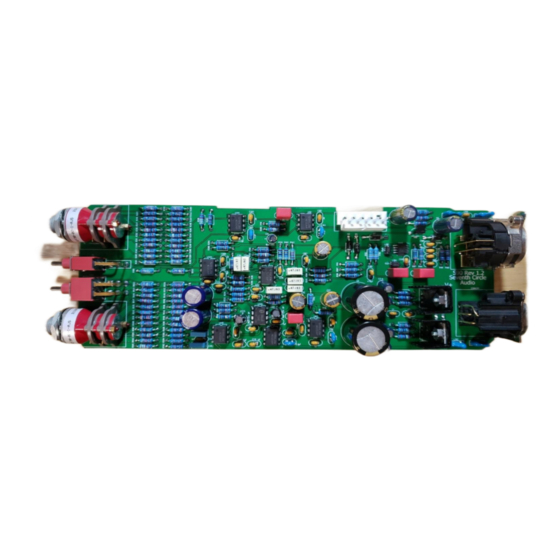
Advertisement
Quick Links
Seventh Circle Audio
Who Should Build This Kit?
The S90 is not difficult to build, but it is not intended for beginners. If you've never built an
electronic project before, this is definitely not the one to start with. To guarantee success, make
sure you have:
•
The ability to make basic voltage and resistance measurements using a digital
multimeter (DMM).
•
At least a rudimentary understanding of voltage, current, and resistance.
•
Some experience soldering on printed circuit boards.
•
The patience to follow instructions precisely and work carefully.
Essential Tools
Fine tipped, 20-30 watt soldering iron w/ cleaning sponge (Hakko 936 or similar)
Eutectic (63/37) rosin core or "no clean" solder (.025" diameter or smaller is best)
Good-quality DMM
Small needle nose pliers
Small diagonal cutters
Phillips screwdriver (#1)
Precision straight blade screwdriver (for adjusting potentiometers)
Highly Recommended Tools
Lead bender (Mouser 5166-801)
T-Handle wrench and 4-40 tap (Hanson 12001 and 8012)
MOLEX crimp tool (Waldom W-HT1919 or equivalent)
Magnifying glass
Optional Tools
Panavise w/ circuit board head
Oscilloscope
Signal generator
Work Area
Find a clean, flat, stable, well-lit surface on which to work. An anti-static mat is recommended
for this project. If you're in a dry, static-prone environment, it's essential. The importance of
good lighting can't be overstated. Component markings are tiny, and you'll be deciphering a lot
of them.
S90 Microphone Preamp Rev 1.2
Pag e 1 o f 11
Advertisement

Summary of Contents for Seventh Circle Audio S90
- Page 1 Who Should Build This Kit? The S90 is not difficult to build, but it is not intended for beginners. If you’ve never built an electronic project before, this is definitely not the one to start with. To guarantee success, make sure you have: •...
- Page 2 C84 Assembly Instructions Soldering Technique Make sure your irons tip is tinned properly and keep it clean! The trick to making perfect solder joints is to heat the joint quickly and thoroughly before applying the solder, and a properly tinned and clean tip is essential for this. Apply enough solder to form a "fillet" between the lead and the pad, a little mound of solder that smoothly transitions from the plane of the board up to the lead, but don’t use too much.
- Page 3 C84 Assembly Instructions Assembly Before you begin, carefully unpack the kit and examine the parts. Check the contents of each small bag against the BOM to make sure all the parts have been included. If you think something’s missing, please e-mail the details to sales@seventhcircleaudio.com we’ll ship replacement parts ASAP.
- Page 4 C84 Assembly Instructions Insert the 1/4-watt resistors. Check the Bill of Materials (BOM) for help in reading the resistor color bands. It's also a good idea to actually measure each resistor with your DMM as you place it on the board, just in case you've decoded it incorrectly. Don't rely on the photos for component placement.
- Page 5 C84 Assembly Instructions Add the small ceramic capacitors. These capacitors are not polarized and can be installed in either direction, but pay close attention to the capacitor markings! These parts all look alike, but they are not interchangeable. Putting one in the wrong spot will not prevent the preamp from passing signal, but it can seriously impair its performance.
- Page 6 C84 Assembly Instructions Install all other 8-pin IC’s now. Pay close attention to the IC markings. Align the notch on the IC with the notch on the silkscreen outline! IC sockets are not included in the kit and are not recommended. Socketing the ICs will interfere with the ability of the PC board to conduct heat away from the parts.
- Page 7 C84 Assembly Instructions 10. Install the film caps. These parts are not polarized and can be installed in either direction. 11. Add the shorter electrolytic capacitors now, followed by the taller. “BP” caps are not polarized, but the rest are and must be installed the right way around! Be absolutely sure to observe the correct polarity when installing these parts.
- Page 8 C84 Assembly Instructions 12. Carefully mount the toggle switches S1 and S201. Be sure they're seated flat on the board before soldering all the pins. You may find it easier to solder the first pin with the board component side up. 13.
- Page 9 C84 Assembly Instructions 15. Using the hardware supplied, attach heat sinks to U1 and U2 and solder them in place. Make sure to install the regulators correctly! These parts are not the same and are not interchangeable. 16. Install rotary switches. Make sure the switches are fully seated and solder them to the board.
- Page 10 100 ohms, don't apply power. Carefully check your work until you find that short. 21. Connect the PS03 to J1 on the S90 using a WH01 wire harness or similar. Verify that there are no crossed wires or loose crimps in the harness. Be sure the locking ramps engage.
- Page 11 24. If the voltages measured in the two previous steps are off by more than a volt or so, you have problems. Possible things to check are incorrectly installed diodes D1-D8, backwards caps, or shorts around U1 and U2. 25. Congratulations! You've got a working S90 preamp. Page 11 of 11...





Need help?
Do you have a question about the S90 and is the answer not in the manual?
Questions and answers